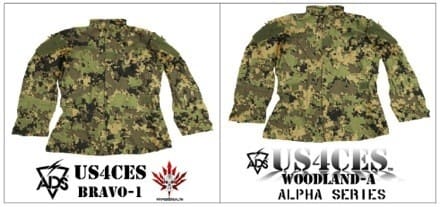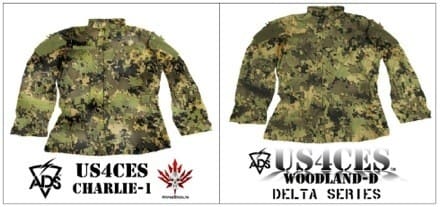ADS Inc. and US4CES designer Guy Cramer, have decided to use Hyperstealth’s print on demand process developed by Cramer, President/CEO of Hyperstealth to release 45 new US4CES patterns in two new series: 15 US4CES Bravo Series patterns and 30 US4CES Charlie Series patterns to the commercial market and for printed camouflage trial material to foreign countries outside of the U.S. looking for a new advanced camouflage uniform.
The Alpha variants of US4CES are finalists in the still unresolved US Army Camouflage Improvement Effort and are not yet available for sale. However, with any of these patterns, you get the same technology improvements offered to the Army but in different colorways. Another difference between Alpha and Bravo, is in the color layering, reversing the order of lightest to darkest colors (the patterns are identical other than the color order). Additionally, none of these are NIR compliant.
The Delta variants were also developed for the US Army and in internal testing Cramer found that they performed better. The Charlie variants have been released for sale commercially. The difference between US4CES Delta and Charlie is in the color layering, reversing the order of lightest to darkest colors.
70/30 Poly/Cotton Lightweight fabric is now available for order in 5 yd increments. So everybody that has been chomping at the bit to get their hands on the US4CES patterns, this is your chance.
For more info visit www.hyperstealth.com/US4CES-Bravo-Charlie.




Now we need cordura and matching webbing.
We are working on the matching Cordura and webbing.
Good to hear. Thank you for the reply
Excellent!
But with one big BUT. Why on Earth can’t you use NIR compliant ink? In contrast, your competition – Crye and Kryptek – do offer military-grade fabrics. What a waste, especially considering that the US4CES is way superior camo to the competition *especially* at NIR [your pics, rumors about the results of the Army tests].
Yes, I know, you offer NIR compliant fabrics too, but unlike your competition, only to selected customers, and only(?) in larger runs.
I’m sure the airsoft communitiy is overjoyed getting the best pattern ever, albeit with reversed color ordering, but what about small-scale tactical gear manufacturers? And mere individuals requiring mil-grade kit?
whoops, I just noticed that Guy had already addressed these points. Still, a huge pitty, and one that will send potential buyers to Crye and Kryptek.
Why on earth is everything such a low cotton percentage now? Cost can’t be that big an issue. They wont breathe worth a crap. This is not the big news I wanted and is confusing as hell. So I have to sew it myself? So what really performs better in a straight up non night vision scenario?
For durability in the Law Enforcement and Military – tactical uniform either NYCO or Poly/Cotton blends are used. For NATO they use 65/35 Poly/Cotton for Durability and comfort. The U.S. uses 50/50 NYCO. We use 70/30 Poly/Cotton due to the lack of fading with the inks we use for the commercial market.
We are working on a Uniform Assembler for this line, it should be a few weeks before you are able to order completed US4CES Bravo and Charlie uniforms.
Actually, cotton costs have sky rocketed over the past few years. But the two most prevalent blends 65/35 PolyCotton and 50/50 NYCO have been around for years and years.
It just seems like 50/50 had been the norm on uniforms, both issue and commercial. I own smocks from 6-7 companies and every one is 50/50. I feel like 65/35 became popular to use as prices went up on cotton, but that seems like a poor reason to use less of it. Now everyone tries to act like it is beneficial to be under 50% cotton for durability of color, overall durability, and faster drying. I don’t buy it.
50/50 = Military = Made in USA
65/35 = LE = Made Overseas, primarily China
Take a look at ECWCS. Not an ounch of cotton, now go figure out why. Hint: Cotton has also pretty much disappeared from ‘technical’ civilian backpacking, climbing etc kit.
Btw, light-weight nylon supplex uniforms (eg by Dropzone tactical) are very comfy, breathable too, in hot conditions. Just not durable enough for the typical grunt usage, and failing at FR.
Not to sound like a major dick, but what’s the point of US4CES without the NIR/SWIR compliance? There are tons of other patterns that are more readily available and equally or more effective in the VS. The real thing that gave US4CES the edge over other patterns was the incredible NIR performance.
NIR is only called compliant when there is a Government specification for that specific pattern of specific reflection levels; many companies use this term to describe their camouflage when in fact, there is no spec. for that camouflage.
We can print in NIR but when we do it can become export restricted and with customers around the world, it would be a logistics nightmare. If your group is legitimate and the order is large enough, we can print with the same NIR/SWIR used on the US4CES Alpha line in the 50/50 NYCO and/or Cordura Nylon.
To clarify we can have both US4CES Bravo and Charlie series produced with the same NIR/SWIR inks (we used on Alpha) on larger orders if your group is approved for export by the U.S. government of this restricted NIR treated material.
Since when the NIR treated fabrics are export restricted? You can buy as much NIR compliant Cordura and NYCO in Multicam or PenCott from Duro Industries as you want without any unnecessary paperwork.
With the SWIR levels reached with US4CES Alpha, the material becomes restricted for export by the U.S. Government. Different countries like Canada (where HyperStealth is located) also have NIR export restrictions in place.
Mr. Cramer – Thank you for the clarification.
BS- I think that it’s a company policy. Hyperstealth has never sold NIR printed camo to the public and they will not sell unit or country specific camo to anyone else. I heard on the rumor mill that the US SF teams couldn’t even get ANA uniforms (there is some kind of NIR IFF feature in them).
The US. Army controls the ANA fabric and uniforms and has made sure that the uniforms are not authorized for anyone except ANA due to security issues.
True. I tried to get a few for role players at our AF military readiness training center, and Army told us no as well.
We had some Pakistani made counterfeit ANA uniforms issued to us for a large scale training exercise. They were a close match from far but you could tell they were cheap knock offs up close. I pointed it out to my S2 but no one gave a shit…
Cool!
Mr.Cramer, I noticed US4CES Bravo 12 and 13 are very similar. Could you explain the difference?
Also, I think it would be useful if you add a range map for each variant. That way people can have a general idea on which pattern would be better suited for them.
“US4CES Delta series is currently in final trials with a very important country ”
I hope that country is the US since it is called U.S. Forces. 😉
Does switching the colors in Bravo version make the pattern in this case more for situations in cover/positive space?
Bravo-12 darkest color is black whet read Bravo-13 is brown.
Yes these will be better in poditive spaces (cover).
Mr Cramer which pattern would you say is the closest to the camouflage competition finalist patterns?
Bravo-1 = US4CES Alpha Woodland – with reversed colors
Bravo-2 = US4CES Alpha Transitional – with reversed colors
Bravo-3 = US4CES Alpha Arid/Desert – with reversed colors
Bravo-4 = US4CES Alpha OCIE coloration – with reversed colors
Would I be correct in assuming there’s no ETA on when the Alpha pattern will be released?
I’m officially burned out on camouflage
Guy,
Could you please offer us some insight on the differences of US4CES Alpha and Delta versions? In particular, any idea why Alpha made it to the Army finals while Delta didn’t?
At first sight, the difference between Alpha and Delta seems to be the overlayer ‘shadowing’ in Delta.
And a big hand to Guy for kindly addressing our questions here 🙂
The difference between US4CES Alpha and Delta is only in the ‘shadowing’ effect on US4CES Delta, this causes the colors to merge into one another like you see with Multicam.
We used the exact same colors in Alpha and Delta so this was our way of not only providing two competing camouflage familes for Phase IV, it would also provide valuable insight into this new trend in camouflage which ran contrary to our research which indicated that the human brain can connect the dots easier (identifying the target quicker) with these color fades ‘shadowing’ where a straight contrast boundary between colors as we see in digital pixelated camouflage was more difficult for the brain to subconsciously piece different contrasting colors together into one part of the target.
ADS Inc. liked the aesthetic look of Delta over Alpha, but Phase IV was not (initially) about aesthetics, it was about effectiveness.
I could have submitted a completely different family with ADS Inc. as our second submission, but then we would not have known how this shadowing really worked.
So we basically let the Army do this test for us, given the size and scope of the down-select testing, it would provide a solid answer if this technique offered any direct benefit to concealment.
The test results matched with what I expected; The shadowing reduced the effectiveness of US4CES Delta which did not make the Phase IV finals compared to the same geometry and same colors (without the shadowing) of US4CES Alpha which did make the finals.
Given these results we can conclude that the shadowing effect in camouflage is purely for aesthetics and does not provide any benefit to the effectiveness, contrarily reducing the overall concealment by allowing the human visual system to connect the dots between these color blends easier than it would be without the shadowing.
by ‘shadowing effect’ do you mean where a color fades into another?
Yes
Perhaps this has already been addressed.
Mr. Cramer If the DOD restarts the camp improvement effort from the beginning as a result of recent legislation would you (hypothetically) resubmit both variants? Just Alpha? Something new? Or say forget you had your chance?
SSD- Do you have insight or speculation into a possible DoD revamp
Of the camp improvement effort? would the Army’s finalists be in or out. Would other patterns like Pencott or Landcamo be allowed in?
Because lives depend on it and this is my expertise, I would do it for that reason and that reason alone, we owe it to those who put their lives on the line for our freedoms to provide them the most effective camouflage pattern(s).
Very glad to see the US4CES patterns coming commercially.
This is going to be a great Christmas.